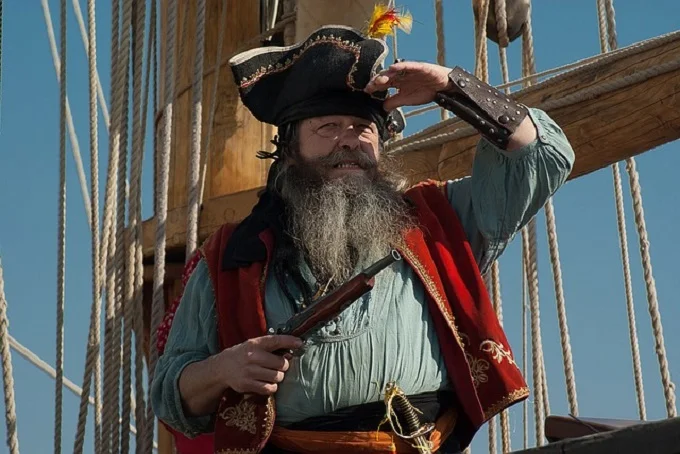The golden age of piracy

Like any other period, maritime piracy had its golden age, with living legends like Bartholomew Roberts, Blackbeard, and Henry Avery. The Golden Age lasted just a little more than 80 years. It took place between 1650 and 1726. Because it occurred during the War of the Spanish Succession and the active time of maritime vessels, when private persons employed warships to take the ships of other powers, the following decades have been very chaotic.
The golden age of piracy is intriguing for many reasons. For example, it is from this period that the present image of the sea-robber originated.
What caused the golden age of piracy

Several reasons contributed to the expansion of piracy in the second half of the seventeenth century:
- By water, substantially more valuable goods were being transported to Europe;
- European powers’ military involvement in some places decreased;
- There arose many well-trained and experienced sailors; The Royal Navy of the United Kingdom has become a valuable supply of troops for pirates;
- Many foreign colonial authorities sent by their governments proved to be ineffective administrators; colonial powers were at odds with one another, making it impossible to conduct a concerted struggle against piracy, though individual efforts were made.
In general, the world suddenly grew so much due to the discovery and development of the New World that states no longer had the power of focus to handle everything at once. They split the colonies, grabbed their wealth, battled, and formed new trading routes. There was a space for pirate freemen during this turbulent period.
There are three periods of the golden age of piracy
Historians adopted the phrase “golden age of piracy” far later than the events that occurred. Contemporaries of Henry Morgan and Edward Teach never adopted this name, even though they may have predicted that the pirates’ atrocities would be remembered in eternity.
The Golden Age of Piracy is usually divided into three periods by historians.
1. The Buccaneers (1650-1680)
Buccaneers were settlers from France and England who were involved in creating Jamaica and Tortuga. Many of them found that hunting and other somewhat legitimate means of making money were insufficient, so they turned to robberies. Buccaneers attacked ships in the Caribbean and the eastern Pacific over the Isthmus of Panama. They were not, however, limited to sea fishing. Buccaneers attacked Spanish territories regularly through overland sorties.
2. The Pirates Round (the 1690s)
This isn’t about some deliberative body; it’s about the pirates’ preferred sea route. Sea robbery became a worldwide phenomenon with the formation of the Pirate Round. Pirates traveled from the western Atlantic to India through Africa, making pauses (for example, in Madagascar) and crossing trade ship routes in various locations. Mughal pilgrims traveling to Muslim shrines and East India Company ships were the most tempting prey for them.
3. The post-Spanish Succession period (1700-1726)
The war lasted from 1701 until 1714, and it turned out to be a big European struggle involving a large number of people. Thousands of sailors were let off when the Peace of Utrecht was signed, and many retrained as pirates. The east coast of America, the west coast of Africa, the Caribbean Sea, and the Indian Ocean are all home to these well-trained and experienced sea wolves.
To get the latest stories, install our app here
The decline of the golden age of piracy

Piracy causes too much loss and must be combated, according to the understanding that developed at the beginning of the 18th century in Europe. The Peace of Utrecht, which established a series of non-aggression pacts and settled the war’s outcome, proved a double-edged sword for pirates. On the one hand, the released seamen boosted the ranks of the sea pirates significantly.
However, not everyone went to rob and kill. European countries began to strengthen the fleets that accompanied merchant ships and catch pirates. Trained sailors who retained their honor went to serve on these ships, and soon they became a real curse for the robbers.
Piracy began to decline in the 1720s. Firstly, European countries have strengthened their navies. Secondly, the strengthening of colonial governments means the loss of pirates of a secure base of operations. The governor of Jamaica refused to welcome Henry Jennings and his crew in 1715, despite the fact that he was bringing a cargo of riches to spend on the island. Jennings needed to establish a new base in the Bahamas, but it barely lasted three years when Governor Woodes Rogers arrived.
The third reason for the decline was the disappearance of the main attraction – Spanish gold and silver. Spain, by that time, had taken out the main treasures from the plundered colonies.
The remaining pirates became wanted criminals. Most of them headed to the west coast of Africa, where they discovered another interesting target: slave ships with little protection. But, as they say, that’s a whole new story.




